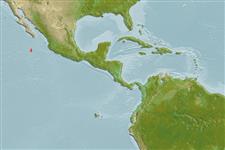>
Blenniiformes (Blennies) >
Chaenopsidae (Pike-, tube- and flagblennies)
Etymology: Acanthemblemaria: Greek, akantha = thorn + Greek, emblema, -atos, anything that is nailed, knocked in; also anything with bass or high relief (Ref. 45335); mangognatha: Name from mango, a tropical fruit with rich orange flesh and the Greek worg 'gnathos' for jaw, referring to the unique coloration on the lwoe jaw (Ref. 81029).
Environment: milieu / climate zone / depth range / distribution range
Ecologia
marino demersale; distribuzione batimetrica 1 - 31 m (Ref. 81029). Tropical; 20°N - 16°N, 112°W - 109°W (Ref. 56272)
Distribuzione
Stati | Aree FAO | Ecosystems | Presenze | Point map | Introduzioni | Faunafri
Eastern Central Pacific: endemic to Revillagigedo Islands, Mexico.
Size / Peso / Age
Maturity: Lm ? range ? - ? cm
Max length : 3.1 cm SL maschio/sesso non determinato; (Ref. 81029)
Short description
Chiavi di identificazione | Morfologia | Morfometria
Spine dorsali (totale) : 23 - 25; Raggi dorsali molli (totale) : 12 - 14; Spine anali: 2; Raggi anali molli: 24 - 27. This species is distinguished by the following characters: anterior one-third of the lower jaw in color, posterior part purple; some large specimens have the supraorbital cirrus deeply branched; a closed wedge of spines on the posterior part of the frontal; 2 rows of interorbital spines, the outer one incomplete, the central row with large spines on a raised ossified ridge; D XXIII-XXV,12-14 (35-38 total dorsal-fin elements; A II,24-27 (Ref. 81029).
A small benthic reef fish which is common in shallow water, but also occurs to depths of at least 31 meters (Ref. 81029).
Life cycle and mating behavior
Maturities | Riproduzione | Spawnings | Egg(s) | Fecundities | Larve
Hastings, P.A. and D.R. Robertson, 1999. Acanthemblemaria atrata and Acanthemblemaria mangognatha, new species of eastern Pacific barnacle blennies (Chaenopsidae) from Isla de Coco, Costa Rica, and Islas Revillagigedo, Mexico, and their relationships with other barnacle blennies. Rev. Fr. Aquariol. 25(3-4):107-118. (Ref. 81029)
IUCN Red List Status (Ref. 130435)
Threat to humans
Harmless
Human uses
Strumenti
Special reports
Download XML
Fonti Internet
Estimates based on models
Preferred temperature (Ref.
123201): 25.8 - 26.2, mean 26 °C (based on 2 cells).
Phylogenetic diversity index (Ref.
82804): PD
50 = 0.5000 [Uniqueness, from 0.5 = low to 2.0 = high].
Bayesian length-weight: a=0.00457 (0.00183 - 0.01143), b=3.08 (2.86 - 3.30), in cm total length, based on LWR estimates for this (Sub)family-body shape (Ref.
93245).
Trophic level (Ref.
69278): 3.3 ±0.4 se; based on size and trophs of closest relatives
Fishing Vulnerability (Ref.
59153): Low vulnerability (10 of 100).
